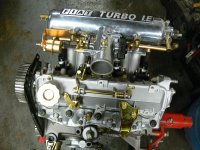The Bosch L-Jetronic fuel injection setup on the 1980-ish X1/9 and Strada for the US market is very similar to the fuel injection setup on the Uno Turbo (the plenum chamber looks like the same casting), and actually I think FIAT/Abarth probably started with those bits when they developed the Uno Turbo.
There are separate ECUs for ignition and injection, as you know. The ignition ECU has a vacuum/pressure sensor. That is essential to map the ignition timing in response to turbo boost. Therefore the ignition ECU will be specific to the Uno Turbo and I think you will be wise to use it. It wouldn't surprise me if the crank sensor/flywheel sensors were the same parts as for the X1/9/Strada (they may not be, but I think they are). I recall something about the need to use the Uno Turbo flywheel with the X1/9 clutch - because the X1/9 flywheel has a different number of teeth.
The injection ECU is probably very similar to the ECU of a standard X1/9 - the airflow meter is the primary input - the injection ECU simply fuels the engine according to the amount of airflow, which will obviously be more as a result of the turbocharger.
So I think you should go ahead and use the Uno Turbo parts. I think the most likely parts to fail are the crankshaft sensors and possibly the distributor rotor and cap. But saying that, my Uno Turbo has been very reliable - those parts are good quality and last a long time. I don't think you will be creating much of a maintenance liability. I've never had to replace anything on my Uno Turbo ignition or injection-wise. I have a long history with the Unos, two X1/9s, and the 128 before that - and I honestly believe that the Uno Turbo Mk1 engine is the best of the lot for reliability - and durability.
Chas is right about the European X1/9 having a carburettor and breaker-points distributor - mine was a 1988 and I was disappointed it had points, considering the Uno had a breakerless distributor since 1986. I started to have intermittent trouble with the points within a year - the engine would cut out when hot, then restart and run fine - I replaced the distributor with a Strada electronic type and had no more problems.
I also had continual problems with the X1/9's carburettor and its silly automatic choke. Flat spots seemed inevitable and it always idled so fast when cold that I could hardly get it into reverse.
<rant> There are many people who are frightened of electronic engine management and who feel that points-and-carbs are 'simple and reliable'. I just don't agree. Simple, perhaps, but reliable - definitely not. Considering the delicate adjustment of the points gap, spring-loaded centrifugal advance, modulated vacuum advance and even retard in some cases, and the mechanical effects at high revs (floating, etc.) it's a wonder it ever worked at all. As for the carburettor, try to explain how it works and the calibration of progression jets, accelerator pump jets, 'full power' diaphragm, etc., and then the operating logic for the choke and fast idle, and I think you'll agree that fuel injection is conceptually far simpler. I know you were never arguing in favour of points-and-carbs, so this doesn't apply to you, but I mention it just to back up how reliable the Uno Turbo electronic ignition/injection is, compared to what went before. <rant off>
The alternative is to do as custard suggested and fit a completely aftermarket ignition and injection system - a lot more expensive, but probably best if you intend to modify the engine for more power (other than turning the boost up to 1 bar, which the standard ECU supports).
Since the X1/9 soldiered on until 1989 and the Uno Turbo was launched in 1985, I wonder why FIAT did not evolve the X1/9 to use the Uno Turbo engine. It would have made perfect sense, but the problem seems to be that the model was put out to pasture at Bertone and kept in a holding pattern for the last six years of its life. The Japanese are masters of 'reheating' an existing design, improving and refining it. The Italians seem to lose interest and eventually start on something all-new instead. Leaving you to pick up where they left off...
Beautiful looking engine, by the way

Well done!
-Alex


